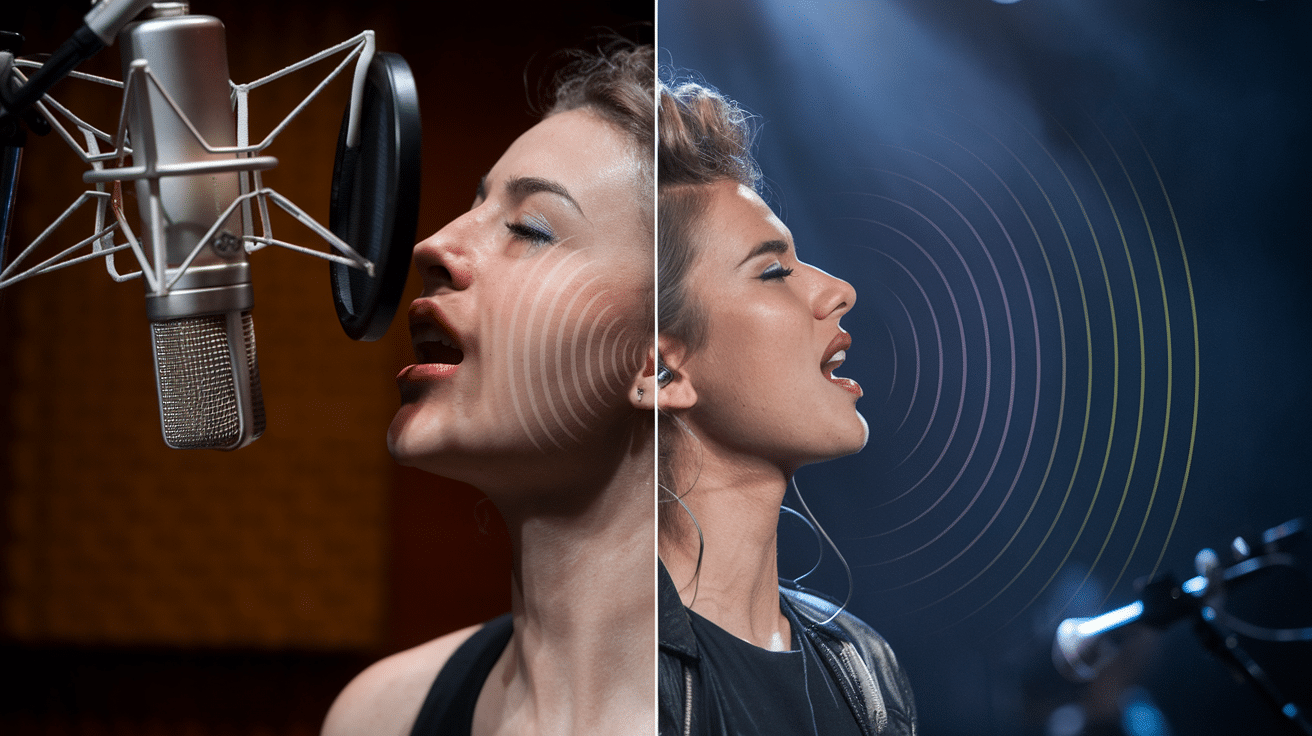Vocal placement is at the heart of exceptional singing and speaking, yet it remains one of the most misunderstood aspects of voice technique.
The difference between amateur and professional sound often comes down to this critical skill.
When mastered, proper vocal placement delivers effortless projection, rich tone, and remarkable stamina while eliminating strain.
Many vocalists struggle for years with limited range and vocal fatigue, unaware that the solution lies in understanding where and how their sound resonates.
Professional singers and speakers rely on these precise methods to maintain vocal health and achieve their signature sound.
The following breakdown of vocal placement fundamentals will revolutionize how you approach your craft.
What is Vocal Placement and Why Does it Matter?
Vocal placement refers to the intentional direction and focus of sound vibrations within the vocal tract when singing or speaking.
It’s essentially where you “feel” your voice resonating in your body as you produce sound.
The significance of vocal placement cannot be overstated. It directly impacts:
- Tone quality: Proper placement creates a richer, more resonant sound with enhanced clarity and projection.
- Vocal endurance: Correct placement reduces strain on the vocal folds, allowing for longer performance times without fatigue.
- Technical control: Mastering placement gives singers precise control over dynamics, articulation, and expressive qualities.
- Stylistic versatility: Understanding how to adjust placement enables singers to perform across different genres authentically.
- Vocal health: Perhaps most importantly, proper placement helps prevent vocal damage and promotes long-term vocal well-being.
Many vocal problems—including tension, breathiness, and limited range—stem from improper placement.
When singers learn to direct their sound effectively, these issues often resolve naturally.
Understanding Vocal Resonance

Vocal resonance is the amplification and enhancement of sound waves produced by the vocal folds as they travel through the various spaces in the vocal tract.
These spaces act as resonating chambers that shape the raw sound into the rich, complex tones we recognize as the human voice.
Unlike instruments with fixed resonators (like a guitar’s body), the human voice has adjustable resonating spaces that can be reshaped through muscular adjustments.
This flexibility allows singers to modify their resonance—and by extension, their vocal placement—to achieve different tonal qualities.
Primary Resonating Chambers
The voice has four main resonating chambers that contribute to vocal placement:
- Chest resonance: Felt in the sternum and ribcage, creating a deep, full sound. It is most prominent in lower pitches, adding warmth and richness.
- Mouth resonance: Occurs in the oral cavity, influenced by tongue, soft palate, and jaw movements. It plays a key role in shaping vowels and articulation.
- Nasal resonance: Vibrates in the nasal cavity, contributing brightness and projection. It is important for stylistic effects, especially in Broadway and folk music.
- Head resonance: Felt in the facial bones and skull, producing bright, clear tones. It helps access upper pitches and maintains a connected vocal sound.
Common Challenges and Solutions

Understanding the common challenges faced by singers is the first step towards improving vocal performance.
Below are some key issues and practical solutions to help overcome them.
Tension and Strain
Causes of Vocal Tension:
- Pushing for volume instead of using proper resonance
- Attempting to control pitch through throat muscles rather than breath support
- Psychological pressure during performance situations
- Misunderstanding of proper technique leading to compensatory tensions
- Poor posture affecting the alignment of the vocal mechanism
Effective Solutions:
Practice gentle onset exercises and progressive relaxation techniques while incorporating semi-occluded vocal tract exercises to establish balanced vocal production.
Record practice sessions to identify tension patterns, then systematically release unnecessary muscular effort while maintaining appropriate engagement.
Inconsistent Resonance
Causes of Inconsistent Resonance:
- Register breaks due to sudden shifts in vocal fold configuration
- Lack of awareness of how resonance naturally changes across the range
- Attempting to maintain one type of resonance throughout the entire range
- Insufficient breath support during register transitions
- Anticipatory tension when approaching difficult passages
Effective Solutions: Practice messa di voce exercises and gradual vocal sirens while implementing strategic vowel modifications to smooth transitions between registers.
Develop kinesthetic awareness of how resonance naturally shifts throughout your range and work on challenging passages at slower tempos initially.
Nasality Issues
Causes of Excessive Nasality:
- Habitually low soft palate position during singing
- Compensating for lack of proper resonance with nasal sound
- Improper vowel formation directing sound into nasal cavity
- Regional speech patterns that emphasize nasal resonance
- Poor awareness of the distinction between nasality and “mask” resonance
Solutions for Balancing Nasal Resonance: Practice alternating between nasal consonants and non-nasal vowels while using physical feedback techniques like nostril monitoring to develop awareness of airflow.
Work with open vowels maintaining proper soft palate height and record yourself to train your ear in distinguishing between beneficial resonance and excessive nasality.
Practical Applications of Vocal Placement

“Practical Applications involve tailoring vocal techniques to fit specific genres and refining performance skills.
By understanding genre-specific considerations and applying proper performance techniques, singers can enhance their vocal delivery and connect more effectively with their audience.”
Genre-Specific Considerations
Different musical genres demand specific vocal placement approaches to achieve their characteristic sounds.
Classical singing emphasizes consistent “mask” placement with significant head resonance and lifted soft palate, creating the characteristic “ring” needed for acoustic projection.
Contemporary pop utilizes speech-like placement with balanced chest-head resonance, taking advantage of microphone amplification for intimacy.
Folk/country uses natural placement with moderate nasality for storytelling clarity, while R&B/soul combines deep chest resonance with strategic head resonance for emotional expression.
Performance Techniques
Understanding how to adapt vocal placement enhances performance effectiveness across various contexts.
Microphone technique allows for intimate placements that wouldn’t project acoustically, while venue adaptation requires adjusting placement based on space size and acoustic properties.
In a studio recording, engineers capture different placements for song sections to create dynamic contrast through production techniques.
In harmonization, slightly different placements between vocalists help each part remain distinct while blending, with background vocals often utilizing more head resonance to complement lead vocals.
Vocal Placement Advice from Famous Singers

Beyoncé – “Feel the sound in your face”
-
Beyoncé has talked about how she feels her voice resonate in her cheeks and forehead, especially for powerful belting. She focuses on placing the sound forward to stay in control and protect her voice.
Freddie Mercury – “Project with purpose”
-
Known for his incredible range and clarity, Mercury emphasized the importance of clear enunciation and forward projection. His technique leaned on mask and head resonance for cutting through loud instruments on stage.
Ariana Grande – “Nasal resonance with balance”
-
Ariana often uses nasal resonance to achieve her signature airy high notes but balances it carefully to avoid sounding overly nasal. She advises singers to record themselves and adjust their placement by ear.
Luciano Pavarotti – “Place the sound like a dome”
-
The opera legend described vocal placement as shaping the sound in the mask area and head like projecting through a rounded dome. He believed this created both power and ease.
Sam Smith – “Support is everything”
-
Sam Smith often credits their control and placement to strong breath support and connecting emotion with technique, noting how proper placement helps convey vulnerability without straining.
Conclusion
Mastering vocal placement requires consistent practice and awareness, but the rewards—improved tone, extended range, and vocal longevity—make it essential for serious vocalists.
Remember that placement sensations are personal; what works perfectly for one voice may feel entirely different for another.
The techniques outlined in this guide provide a starting framework, but your individual anatomy and style will ultimately determine your optimal approach.
Have certain exercises worked better than others for finding your ideal resonance?
Share your experiences in the comments below—your insights might be exactly what another vocalist needs to breakthrough their placement obstacles.
If you’ve found success with these methods, let us know which technique made the biggest difference in your vocal development!














